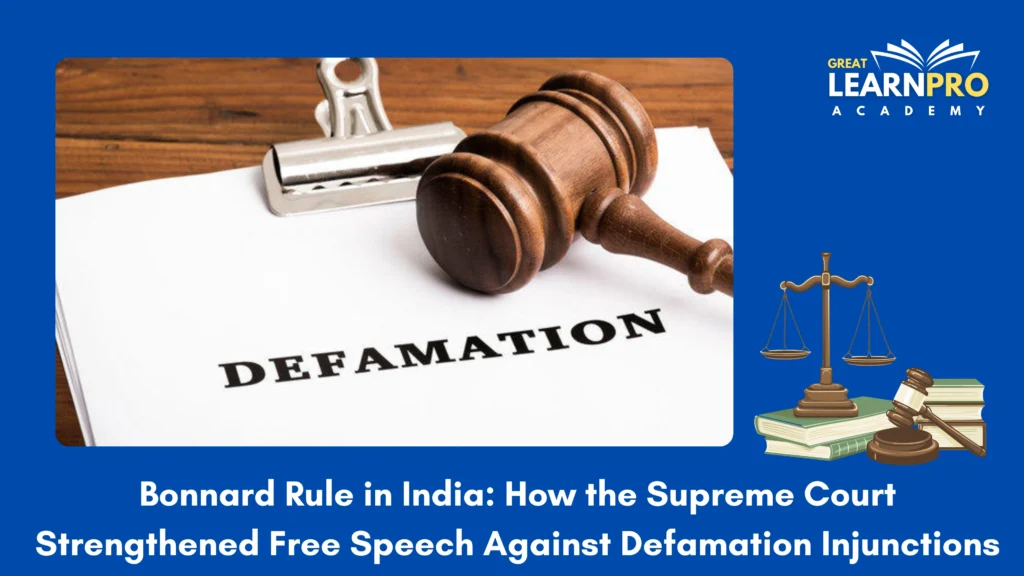The “Bonnard standard” traces to the 1891 English decision Bonnard v Perryman, which established a cautious approach to granting interim (pre-trial) injunctions in libel and defamation actions. The core idea is simple but powerful: because injunctive relief prior to trial can shut down speech permanently (or effectively), courts should not grant such orders where the defendant raises a bona-fide defence of justification (truth) or other substantive defences, unless the claimant can show the defendant is certain to fail at trial in short, the plaintiff must make out an exceptionally strong case on the merits before a court silences publication.

Why the rule matters today
Two features make Bonnard enduringly important. First, it protects freedom of expression and the public’s right to know by preventing prior restraint based on untested allegations. Second, it recognises the structural asymmetry of interim relief: a takedown or injunction granted before a full trial can be a de-facto “death sentence” for the material even if the publisher later wins damages. For these reasons, English and many common-law jurisdictions have treated Bonnard as a controlling touchstone when free speech and reputation collide.
The Indian Supreme Court’s recent intervention(s)
Until very recently, Indian courts followed the standard three-fold test for interim injunctions (prima facie case, balance of convenience, irreparable harm). But in practice, ex-parte ad-interim injunctions in defamation suits especially against media and journalists began to raise concerns about censorship and SLAPPs (Strategic Litigation Against Public Participation). In March–April 2024 the Supreme Court stepped in on this tension in Bloomberg Television Production Services India Pvt. Ltd. & Ors. v. Zee Entertainment Enterprises Ltd. The Court set aside an ex-parte order of a trial court (and an affirming order of the Delhi High Court) that had directed Bloomberg to take down an article. The bench emphasised that pre-trial injunctions against publication “may have severe ramifications on the right to freedom of speech … and the public’s right to know,” and warned that an interim injunction should not be granted unless the content is shown to be “malicious” or “palpably false.” The Court expressly held that courts must apply the Bonnard standard and exercise exceptional caution before issuing prior restraints.
What the Bloomberg ruling changed (practical effect)
The Supreme Court’s order is significant for three reasons. First, it operationalised Bonnard within India’s constitutional framework: when media/journalists are the target, courts must weigh Article 19(1)(a) strongly and deny ex-parte restraints unless the plaintiff’s case is overwhelming. Second, the Court flagged SLAPP litigation as a real problem and indicated that interim relief is the most effective chokehold used by powerful litigants to silence reporting. Third, the ruling required lower courts to engage more substantively with facts before granting injunctions a rote recital of the three-fold test is inadequate; judges must explain why restraint is necessary and why defences are unlikely to succeed.
Aftershocks: how lower courts and commentators have reacted
Since the Bloomberg decision, several high-profile district and high-court orders have been reviewed against the Bonnard yardstick. Some lower courts have resisted blanket takedowns by scrutinising whether the defendant can realistically establish truth or other defences at trial; others have still issued aggressive interim orders in exceptional contexts (privacy, trade secrets, national security), prompting detailed judicial reasoning to justify restraint. Legal commentators view the Supreme Court’s approach as creating a de-facto mini-anti-SLAPP shield not formal statute, but a jurisprudential barrier against abuse of defamation procedure.
Limitations and open questions
Bonnard is not absolute. Where allegations are manifestly baseless, malicious, or involve narrow private harms not in the public interest, an injunction may still be appropriate. The line between legitimate reputational protection and censorious SLAPPs will continue to be litigated: lower courts must balance competing rights carefully and explain their reasoning. Also, Bonnard was born in an era of juries and print media; courts must now apply its logic in a digital age of virality, platform intermediaries and takedown mechanics a doctrinal update, not a repeal, is what practitioners and scholars are calling for.
Conclusion
The Bonnard standard remains a cornerstone in the law of interim relief in defamation suits because it protects speech from premature judicial suppression. India’s Supreme Court brought Bonnard into constitutional focus in the Bloomberg case, warning courts against easy use of ex-parte injunctions and signalling judicial hostility to SLAPP-style gagging. The practical effect is a higher hurdle for plaintiffs seeking pre-trial censorship of publications a development likely to shape media litigation and public interest reporting for years to come.
Sources:
- https://www.scconline.com/blog/post/2024/03/26/sc-set-aside-order-directing-bloomberg-to-remove-article-on-zee-entertainment-legal-news/?utm_
- https://indianexpress.com/article/explained/prior-restraint-gag-order-in-adani-case-flies-in-face-of-what-sc-has-ruled-10258396/?utm_
- https://globalfreedomofexpression.columbia.edu/cases/bloomberg-v-zee-entertainment/?utm_
More Current affairs: https://learnproacademy.in/updates/
